You're using an outdated browser. Please upgrade to a modern browser for the best experience.
Please note this is a comparison between Version 2 by Camila Xu and Version 1 by Valérie Maraval.
Dendrimers, arborescent macromolecules exhibiting a large number of functional groups at their surface, appeared as naturally attractive targets to consider as TPA chromophores. Indeed, dendrimers are a special kind of perfectly defined hyperbranched polymers constructed stepwise from a multifunctional core at the periphery of which can be grafted a large density and variety of chromophores.
- dendrimer
- two-photon absorption
- optical power limitation
- photopolymerization
1. Introduction
After the theoretical prediction of the two-photon absorption (TPA) process by M. Göppert Mayer in 1931 [1], and the first experimental evidence of the phenomenon 30 years later [2], this third-order non-linear optical property has received considerable attention. Indeed, the TPA process is involved in a wide range of applications such as three-dimensional microfabrication [3], optical limitation [4], photodynamic therapy [5], or optical data storage [6]. Depending on the targeted application, TPA chromophores have to exhibit specific characteristics such as high fluorescence and/or solubility in aqueous media, for example. Many structure activity relationship studies were reported, and a large number of new organic dyes were designed and synthesized with the objective of reaching high TPA efficiencies [7]. The efficiency of a TPA chromophore is given by its cross-section value (σTPA), expressed in Göppert-Mayer (1 GM = 10−50 cm4 s photon−1).
In the design of chromophores for two-photon absorption, dipolar structures D-π-A, in which a donor group D is separated from an acceptor group A by a π-conjugated bridge, were first investigated [8], followed by quadrupolar molecules D-π-D or A-π-A [9]. These studies evidenced that D-π-D or D-π-A-π-D chromophores are generally more efficient than A-π-A or A-π-D-π-A counterparts [10]. Later, octupolar branched molecules were investigated and were shown to be efficient TPA chromophores [11].
Dendrimers, macromolecules exhibiting a large number of functional groups at their surface, appeared as the natural next targets to investigate as TPA chromophores. Indeed, dendrimers are a special kind of perfectly defined hyperbranched polymers constructed stepwise from a multifunctional core [12]. Their synthesis is most of the time performed through a divergent method and involves the use of a branched monomer. The repetition of a two-step sequence of reactions allows the progressive growth of the branches of the dendrimer and an increase in the number of terminal functions. A new generation (Gn + 1) of the dendrimer is created each time the number of functional groups is multiplied, generally by two [13] (up to five in some cases) [14], thanks to the use of the branched monomer. Dendrimers are thus defined by their core, their branches, their generation (a new generation being created each time a branching point is introduced through the use of the branched monomer) and their peripheral (or surface) functions. In the last decades, dendrimers were reported to possess a large variety of properties, depending on their structure, size, and functionalization at the surface or core, and to open up prospects for many applications in the fields of nanomaterials, catalysis, or biology, for example [15].
2. Two-Photon Absorbing Dendrimers
The first report of a TPA cross-section of a dendrimer was published by M. G. Humphrey in 1999 [16]. This pioneer study was performed on organometallic alkynylruthenium dendrimers and showed that the TPA cross-section value measured for 1-G1 (σTPA = 4800 ± 500 GM) was much higher than the value obtained for the smaller dendrimer 1-G0 (σTPA = 700 ± 120 GM) (Figure 1). Interestingly, the value for 1-G1 was higher than the one calculated by the addition of the values measured for each constitutive motif of the molecule. This non-linear increase of the TPA cross-section values from 1-G0 to 1-G1 was the first observation of a dendritic effect, or multivalence effect, on the TPA property. Such dendritic effects, though not clearly explained, have been observed in different domains, such as for example in catalysis and in TPA properties [17].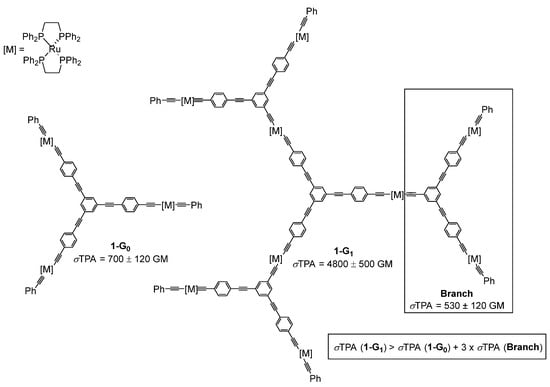
Figure 1.
First example of TPA cross-section measurements of organometallic dendrimers.
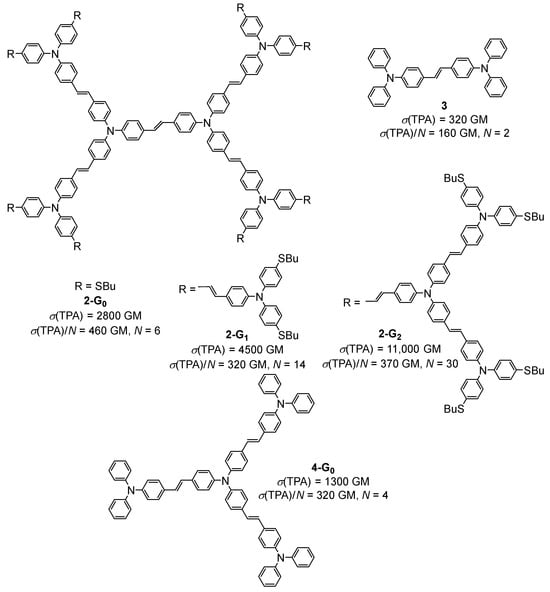
Figure 2.
Structures and TPA cross-section values of bis-(diphenylamino)stilbene-based dendrimers.
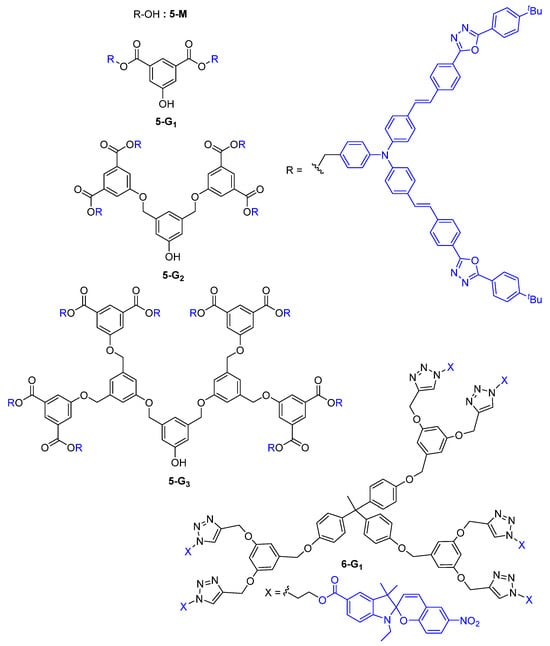
Figure 3.
Non-conjugated dendrimers envisaged as TPA chromophores.
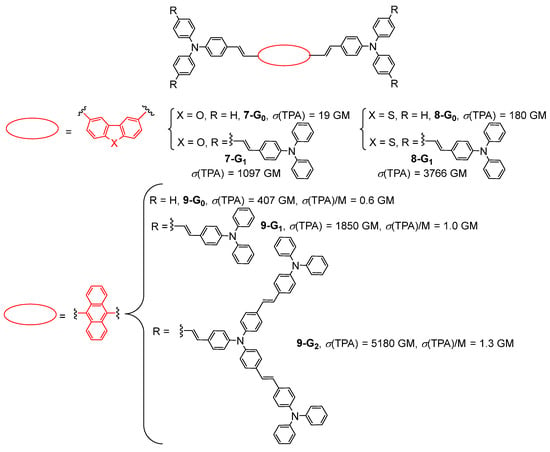
Figure 4.
Bis-(diphenylamino)stilbene-based dendrimers with various cores.
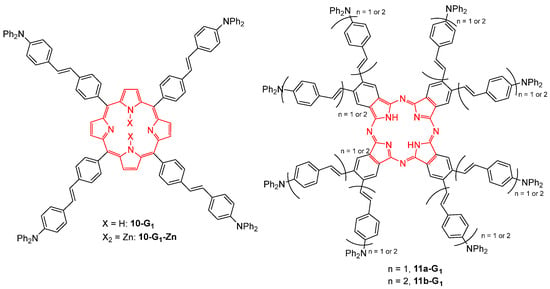
Figure 5.
Dendritic TPA chromophores with tetrapyrrolic cores.
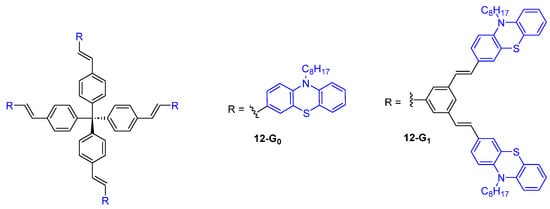
Figure 6.
Dendrimers with a tetraphenylmethane core and phenothiazine substituents.
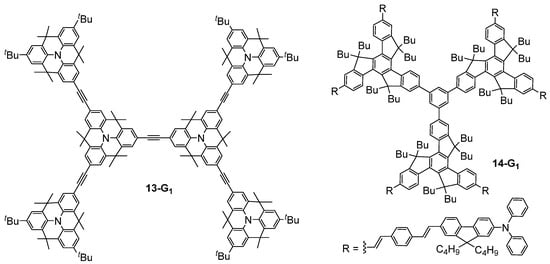
Figure 7.
Structure of dendritic TPA chromophores with enhanced rigidity.
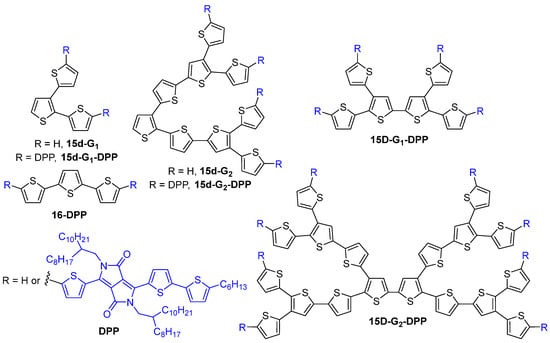
Figure 8.
All-thiophene dendrons and dendrimers.
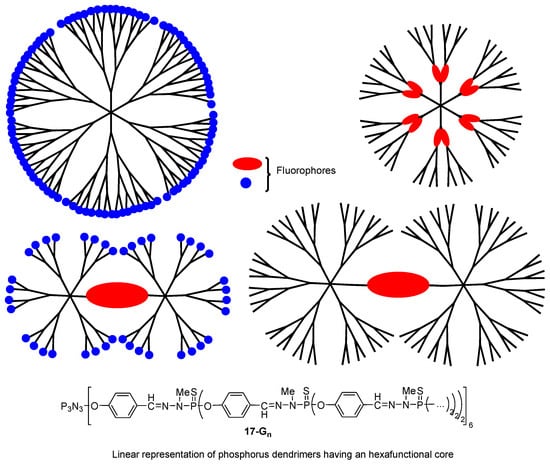
Figure 9. Schematic representations of the different types of phosphorous dendrimers embedding fluorophores in their structure.
References
- Göppert-Mayer, M. Über Elementarakte mit zwei Quantensprüngen. Ann. Phys. 1931, 401, 273–294.
- Kaiser, W.; Garrett, C.G.B. Two-Photon Excitation in CaF2:Eu2+. Phys. Rev. Lett. 1961, 7, 229–231.
- Xing, J.-F.; Zheng, M.-L.; Duan, X.-M. Two-photon polymerization microfabrication of hydrogels: An advanced 3D printing technology for tissue engineering and drug delivery. Chem. Soc. Rev. 2015, 44, 5031–5039.
- Pascal, S.; David, S.; Andraud, C.; Maury, O. Near-infrared dyes for two-photon absorption in the short-wavelength infrared: Strategies towards optical power limiting. Chem. Soc. Rev. 2021, 50, 6613–6658.
- Ogawa, K.; Kobuke, Y. Two-Photon Photodynamic Therapy by Water-Soluble Self-Assembled Conjugated Porphyrins. BioMed Res. Int. 2013, 2013, 125658.
- Ogawa, K. Two-Photon Absorbing Molecules as Potential Materials for 3D Optical Memory. Appl. Sci. 2014, 4, 1–18.
- Myung Kim, H.; Cho, B.R. Two-photon materials with large two-photon cross sections. Structure–property relationship. Chem. Commun. 2009, 2009, 153–164.
- Rebane, A.; Drobizhev, M.; Makarov, N.S.; Beuerman, E.; Haley, J.E.; Krein, D.M.; Burke, A.R.; Flikkema, J.L.; Cooper, T.M. Relation between Two-Photon Absorption and Dipolar Properties in a Series of Fluorenyl-Based Chromophores with Electron Donating or Electron Withdrawing Substituents. J. Phys. Chem. A 2011, 115, 4255–4262.
- Lee, S.K.; Yang, W.J.; Choi, J.J.; Kim, C.H.; Jeon, S.-J.; Cho, R.B. 2,6-Bisanthracene Derivatives with Large Two-Photon Cross Sections. Org. Lett. 2005, 7, 323–326.
- Mongin, O.; Porrès, L.; Charlot, M.; Katan, C.; Blanchard-Desce, M. Synthesis, Fluorescence, and Two-Photon Absorption of a Series of Elongated Rodlike and Banana-Shaped Quadrupolar Fluorophores: A Comprehensive Study of Structure–Property Relationships. Chem.-Eur. J. 2007, 13, 1481–1498.
- Ceymann, H.; Roopeintner, A.; Schreck, M.H.; Mützel, C.; Stoy, A.; Vauthey, E.; Lambert, C. Cooperative enhancement versus additivity of two-photon-absorption cross sections in linear and branched squaraine superchromophores. Phys. Chem. Chem. Phys. 2016, 18, 16404–16413.
- Tomalia, D.A.; Baker, H.; Dewald, J.; Hall, M.; Kallos, G.; Martin, S.; Roeck, J.; Ryder, J.; Smith, P. A New Class of Polymers: Starburst-Dendritic Macromolecules. Polym. J. 1985, 17, 117–132. Available online: https://www.nature.com/articles/pj198510 (accessed on 1 January 1985).
- Newkome, G.R.; Shreiner, C.D. Poly(amidoamine), polypropylenimine, and related dendrimers and dendrons possessing different 1→2 branching motifs: An overview of the divergent procedures. Polymer 2008, 49, 1–173.
- Maraval, V.; Caminade, A.-M.; Majoral, J.-P.; Blais, J.-C. Dendrimer Design: How to Circumvent the Dilemma of a Reduction of Steps or an Increase of Function Multiplicity? Angew. Chem. Int. Ed. 2003, 42, 1822–1826.
- Caminade, A.-M. Inorganic Dendrimers and Their Applications. In Smart Inorganic Polymers; Wiley: Weinheim, Germany, 2019; pp. 277–315.
- McDonagh, A.M.; Humphrey, M.G.; Samoc, M.; Luther-Davies, B. Organometallic Complexes for Nonlinear Optics. 17.1 Synthesis, Third-Order Optical Nonlinearities, and Two-Photon Absorption Cross Section of an Alkynylruthenium Dendrimer. Organometallics 1999, 18, 5195–5197.
- Caminade, A.-M.; Ouali, A.; Laurent, R.; Turrin, C.-O.; Majoral, J.-P. The dendritic effect illustrated with phosphorus dendrimers. Chem. Soc. Rev. 2015, 44, 3890–3899.
- Powell, C.E.; Morrall, J.P.; Ward, S.A.; Cifuentes, M.P.; Notaras, E.G.A.; Samoc, M.K.; Humphrey, M.G. Dispersion of the Third-Order Nonlinear Optical Properties of an Organometallic Dendrimer. J. Am. Chem. Soc. 2004, 126, 12234–12235.
- Cifuentes, M.P.; Powell, C.E.; Morrall, J.P.; McDonagh, A.M.; Lucas, N.T.; Humphrey, M.G.; Samoc, M.; Houbrechts, S.; Asselberghs, I.; Clays, K.; et al. Electrochemical, Spectroelectrochemical, and Molecular Quadratic and Cubic Nonlinear Optical Properties of Alkynylruthenium Dendrimers1. J. Am. Chem. Soc. 2006, 128, 10819–10832.
- Green, K.A.; Simpson, P.V.; Corkery, T.C.; Cifuentes, M.P.; Samoc, M.; Humphrey, M.G. Divergent Synthesis of Ruthenium Alkynyl Dendrimers and a Two-Photon Absorption Cross-Section Dendritic Effect. Macromol. Rapid Commun. 2012, 33, 573–578.
- Simpson, P.V.; Watson, L.A.; Barlow, A.; Wang, G.; Cifuentes, M.P.; Humphrey, M.G. Record Multiphoton Absorption Cross-Sections by Dendrimer Organometalation. Angew. Chem. Int. Ed. 2016, 55, 2387–2391.
- Elandaloussi, E.H.; Spangler, C.W.; Dirk, C.; Casstevens, M.; Kumar, D.; Burzynski, R. Design and Synthesis of Dendrimers with Enhanced Two-Photon Absorption. MRS Proc. 1999, 561, 63–68. Available online: https://link.springer.com/article/10.1557/PROC-561-63 (accessed on 10 February 2011).
- Drobizhev, M.; Karotki, A.; Rebane, A.; Spangler, C.W. Dendrimer molecules with record large two-photon absorption cross section. Opt. Lett. 2001, 26, 1081–1083.
- Drobizhev, M.; Karotki, A.; Kruk, M.; Dzenis, Y.; Rebane, A.; Meng, F.; Nickel, E.; Spangler, C.W. Strong two-photon absorption in new porphyrins with asymmetrical meso-substitution. Proc. SPIE 2003, 5211, 63–74.
- Zhou, X.; Ren, A.-M.; Feng, J.-K.; Liu, X.-J.; Zhang, G. Theoretical investigation on dendritic molecules with large two-photon absorption cross section. J. Mol. Struct. (Theochem.) 2004, 672, 175–182.
- Zhang, X.-B.; Feng, J.-K.; Ren, A.-M.; Zhao, X.-J.; Sun, C.-C. Theoretical study of two-photon absorption properties for triphenylamine (boron, aluminum)-cored dendritic compounds. J. Mol. Struct. (Theochem.) 2006, 764, 69–75.
- Mukhopadhyay, S.; Ramasesha, S. Study of linear and nonlinear optical properties of dendrimers using density matrix renormalization group method. J. Chem. Phys. 2009, 131, 074111. Available online: https://pubs.aip.org/jcp/article/131/7/074111/188135/Study-of-linear-and-nonlinear-optical-properties (accessed on 20 August 2009).
- Adronov, A.; Fréchet, J.M.J. Novel Two-Photon Absorbing Dendritic Structures. Chem. Mater. 2000, 12, 2838–2841. Available online: https://pubs.acs.org/doi/10.1021/cm000586o (accessed on 23 September 2000).
- Zhang, Q.; Ning, Z.; Yan, Y.; Qian, S.; Tian, H. Photochromic Spiropyran Dendrimers: ‘Click’ Syntheses, Characterization, and Optical Properties. Macromol. Rapid Commun. 2008, 29, 193–201.
- Wang, X.; Yang, P.; Li, B.; Jiang, W.; Huang, W.; Qian, S.; Tao, X.; Jiang, M. Two-photon absorption of new multibranched chromophore with dibenzothiophene core. Chem. Phys. Lett. 2006, 424, 333–339.
- Wang, D.; Qin, C.; Wang, X.; Jiang, W.; Fang, X.; Zhao, J.; Chen, G. Synthesis of branched-chromophores with enhanced two-photon absorption via core effect. Optics Mat. 2009, 31, 805–811.
- Xu, B.; Zhang, J.; Fang, H.; Ma, S.; Chen, Q.; Sun, H.; Im, C.; Tian, W. Aggregation induced enhanced emission of conjugated dendrimers with a large intrinsic two-photon absorption cross-section. Polym. Chem. 2014, 5, 479–488.
- Rebane, A.; Makarov, N.; Drobizhev, M.; Spangler, C.W.; Gong, A.; Meng, F. Broad bandwidth near-IR two-photon absorption in conjugated porphyrin-core dendrimers. Proc. SPIE 2007, 6653, 665307.
- Qiu, X.; Lu, R. Synthesis and two-photon properties of phenothiazine-based dendrimers with tetraphenylmethane cores. Optical Mat. 2021, 112, 110550.
- Varnavski, O.; Yan, X.; Mongin, O.; Blanchard-Desce, M.; Goodson, T., III. Strongly Interacting Organic Conjugated Dendrimers with Enhanced Two-Photon Absorption. J. Phys. Chem. C 2007, 111, 149–162.
- Mongin, O.; Brunel, J.; Porrès, L.; Blanchard-Desce, M. Synthesis and two-photon absorption of triphenylbenzene-cored dendritic chromophores. Tetrahedron Lett. 2003, 44, 2813–2816.
- Fang, Z.; Teo, T.-L.; Cai, L.; Lai, Y.-H.; Samoc, A.; Samoc, M. Bridged Triphenylamine-Based Dendrimers: Tuning Enhanced Two-Photon Absorption Performance with Locked Molecular Planarity. Org. Lett. 2009, 11, 1–4.
- Zheng, Q.; He, G.S.; Prasad, P.N. π-Conjugated Dendritic Nanosized Chromophore with Enhanced Two-Photon Absorption. Chem. Mater. 2005, 17, 6004–6011.
- Ramakrishna, G.; Bhaskar, A.; Bäuerle, P.; Goodson, T., III. Oligothiophene Dendrimers as New Building Blocks for Optical Applications. J. Phys. Chem. A 2008, 112, 2018–2026.
- Harpham, M.R.; Süzer, Ö.; Ma, C.-Q.; Bäuerle, P.; Goodson, T., III. Thiophene Dendrimers as Entangled Photon Sensor Materials. J. Am. Chem. Soc. 2009, 131, 973–979.
- Kang, G.; Avanaki, K.N.; Mosquera, M.A.; Burdick, R.K.; Villabona-Monsalve, J.P.; Goodson, T., III; Schatz, G.C. Efficient Modeling of Organic Chromophores for Entangled Two-Photon Absorption. J. Am. Chem. Soc. 2020, 142, 10446–10458.
- Giri, S.J.; Schatz, G.C. Manipulating Two-Photon Absorption of Molecules through Efficient Optimization of Entangled Light. J. Phys. Chem. Lett. 2022, 13, 10140–10146.
- Javanainen, J.; Gould, P.L. Linear intensity dependence of a two-photon transition rate. Phys. Rev. A 1990, 41, 5088–5091.
- Gao, W.; Luo, Q.; Wang, J.; Lin, Y.; Tang, C.; Dou, J.; Tan, H.; Zheng, Q.; Ma, C.-Q.; Cui, Z. Peripherally diketopyrrolopyrrole-functionalized dendritic oligothiophenes—synthesis, molecular structure, properties and applications. Polym. Chem. 2017, 8, 1460–1476.
- Caminade, A.-M.; Turrin, C.-O.; Majoral, J.-P. Phosphorous Dendrimers in Biology and Nanomedecine—Synthesis, Characterization, and Properties, 1st ed.; Jenny Stanford Publishing Pte., Ltd.: New York, NY, USA, 2018.
- Larson, D.R.; Zipfel, W.R.; Williams, R.M.; Clark, S.W.; Bruchez, M.P.; Wise, F.W.; Webb, W.W. Water-Soluble Quantum Dots for Multiphoton Fluorescence Imaging in Vivo. Science 2003, 300, 1434–1436. Available online: https://www.science.org/doi/10.1126/science.1083780 (accessed on 30 May 2003).
- Mongin, O.; Krishna, T.R.; Wertz, M.H.V.; Caminade, A.-M.; Majoral, J.-P.; Blanchard-Desce, M. A modular approach to two-photon absorbing organic nanodots: Brilliant dendrimers as an alternative to semiconductor quantum dots? Chem. Commun. 2006, 2006, 915–917.
- Terenziani, F.; Parthasarathy, V.; Pla-Quintana, A.; Maishal, T.; Caminade, A.-M.; Majoral, J.-P.; Blanchard-Desce, M. Cooperative Two-Photon Absorption Enhancement by Through-Space Interactions in Multichromophoric Compounds. Angew. Chem. Int. Ed. 2009, 48, 8691–8694.
- Robin, A.-C.; Parthasarathy, V.; Pla-Quintana, A.; Mongin, O.; Terenziani, F.; Caminade, A.-M.; Majoral, J.-P.; Blanchard-Desce, M. Cooperative TPA enhancement via through-space interactions in organic nanodots built from dipolar chromophores. Proc. SPIE 2010, 7774, 77740N.
- Rouxel, C.; Charlot, M.; Mongin, O.; Krishna, T.R.; Caminade, A.-M.; Majoral, J.-P.; Blanchard-Desce, M. From Graftable Biphotonic Chromophores to Water-Soluble Organic Nanodots for Biophotonics: The Importance of Environmental Effects. Chem.-Eur. J. 2012, 18, 16450–16462.
- Mongin, O.; Rouxel, C.; Vabre, J.-M.; Mir, Y.; Pla-Quintana, A.; Wei, Y.; Caminade, A.-M.; Majoral, J.-P.; Blanchard-Desce, M. Customized multiphotonics nanotools for bioapplications: Soft organic nanodots as an eco-friendly alternative to quantum dots. Proc. SPIE 2009, 7403, 740303.
- Mongin, O.; Pla-Quintana, A.; Terenziani, F.; Drouin, D.; Le Droumaguet, C.; Caminade, A.-M.; Majoral, J.-P.; Blanchard-Desce, M. Organic nanodots for multiphotonics: Synthesis and photophysical studies. New J. Chem. 2007, 31, 1354–1367.
- Caminade, A.-M.; Zibarov, A.; Diaz, E.C.; Hameau, A.; Klausen, M.; Moineau-Chane Ching, K.; Majoral, J.-P.; Verlhac, J.-B.; Mongin, O.; Blanchard-Desce, M. Fluorescent phosphorus dendrimers excited by two photons: Synthesis, two-photon absorption properties and biological uses. Belstein J. Org. Chem. 2019, 15, 2287–2303.
More
